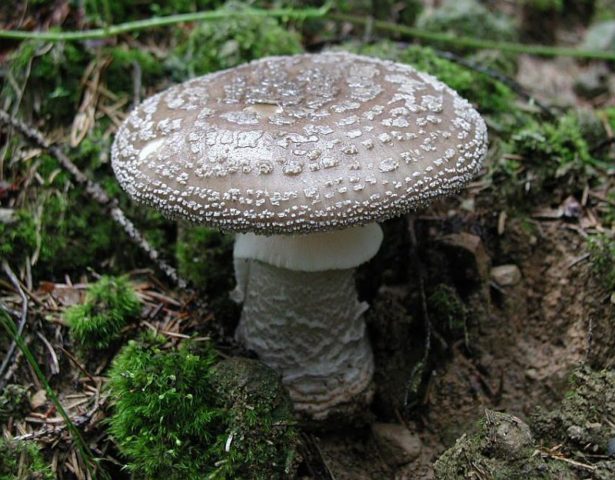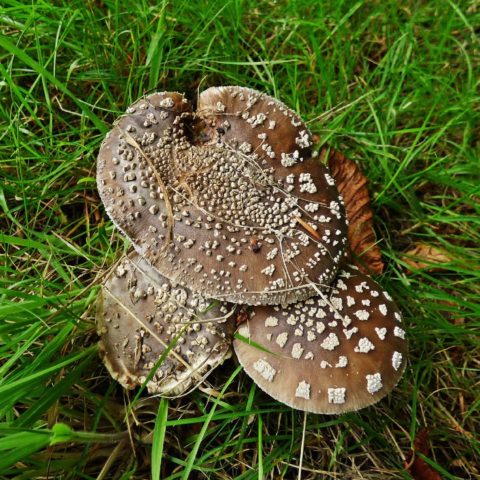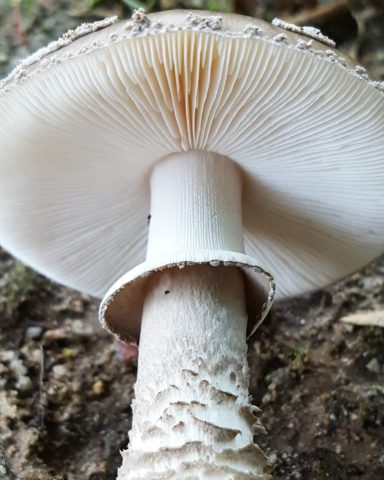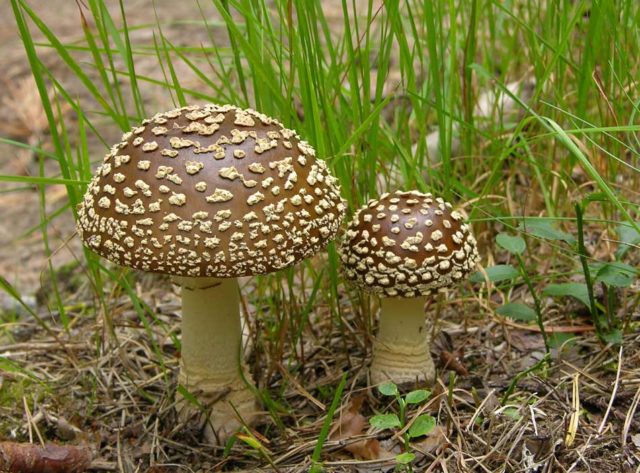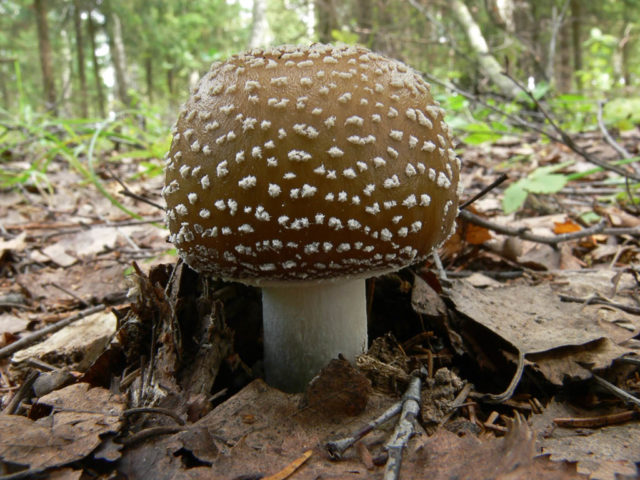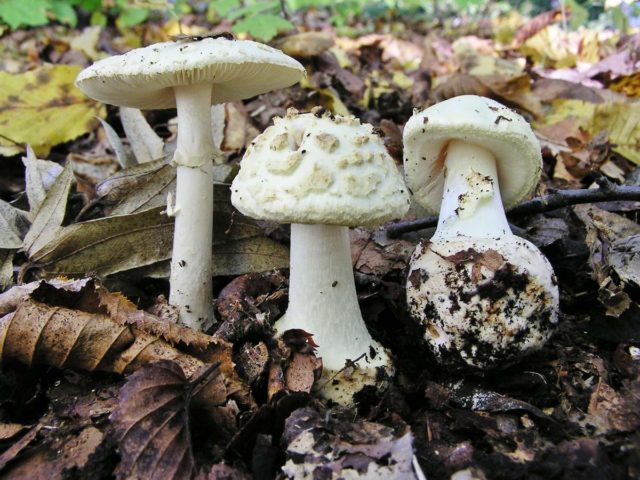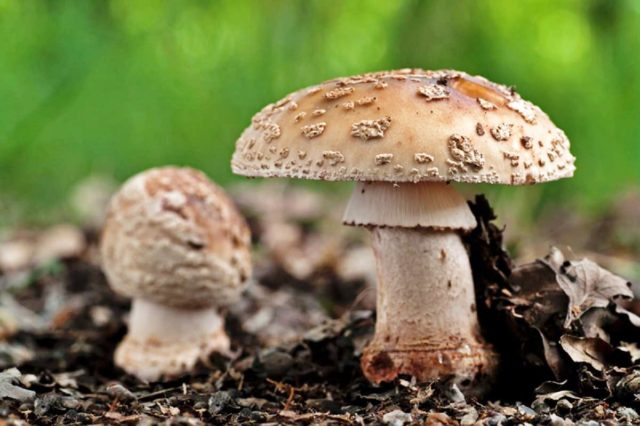Content
Amanita muscaria belongs to the Amanita family. This mushroom is found in summer and autumn. Although the variety is classified as conditionally edible, it is not recommended to eat it. Fruit bodies require long processing, while their taste is mediocre. The most dangerous are its counterparts - other members of the family. They are poisonous to humans and cause poisoning.
Description of thick fly agaric
According to the photo, the thick fly agaric is a lamellar mushroom. Its fruit can be divided into a leg and a cap. The variety is also known by other names - tall or stocky fly agaric.
Description of the hat
The upper part measures from 6 to 10 cm. In the largest specimens, the cap grows to a diameter of 15 cm. Its shape is hemispherical, becoming convex and flat over time. Fibrous, smooth edges. The surface is slimy after rains. In clear weather, it is silky, brown or gray in color. In the central part, the color is darker.
Young representatives have a blanket on their hat. As the fungus grows, gray, scaly remnants, similar to flakes, remain on it. The plates are white, narrow, frequent, adherent to the peduncle. Spores are also white.
Leg description
The stem is light colored, brownish or gray. A fibrous ring is located in the upper part. Height from 5 to 15 cm, thickness - up to 3 cm. The shape is cylindrical, there are cavities inside. The base of the leg is thickened, resembling a mace. The pulp is white, the taste and smell are weak, reminiscent of radish or anise.
Doubles and their differences
The fat fly agaric has twins. These are mushrooms that have similar external characteristics. This mainly includes other species that belong to the Amanita family. Most of them are poisonous, they are not eaten.
The main counterparts of the thick fly agaric:
- Amanita muscaria. Poisonous variety, has a cap measuring from 5 to 25 cm. Its shape is spherical or prostrate, numerous white flakes are located on the surface. The leg is up to 20 cm long and no more than 3.5 cm in diameter. The shape is cylindrical, extended near the base. It is quite difficult to distinguish it from a thick fly agaric: they have a similar color and body structure.
- Amanita muscaria. An inedible poisonous species that grows in mixed and coniferous forests. The hat is up to 12 cm in size, bell-shaped or open. The color is gray, brown, covered with white warts. The plates are white, narrow, and are free. The leg is up to 13 cm long, its diameter reaches 1.5 cm. One of the most dangerous mushrooms, when consumed, causes poisoning. Practically indistinguishable from a thick fly agaric.
- Amanita muscaria. Mushroom with a cap up to 10 cm in size, flat-convex or depressed. The color is white, yellowish-green, covered with white or gray flakes. The pulp is light, yellowish, with an unpleasant taste and smell.Leg up to 10 cm long, up to 2 cm in diameter, hollow, white. It differs from conditionally edible species in a lighter color. The fungus is poisonous and not used for food.
- Amanita is gray-pink. The variety has a cap up to 20 cm in size, spherical or convex. The skin is brown or pinkish. Leg up to 10 cm long, cylindrical. The species is distinguished by pinkish flesh, which is redder after cutting. It is considered conditionally edible, it is used for food after heat treatment.
Where and how does a fat fly agaric grow
The variety is found in coniferous and deciduous forests. It forms mycosis with spruce, pine, fir. Sometimes they grow next to beech and oak. On the territory of Russia, they are found in the middle lane, in the Urals and in Siberia.
For the growth of fruit bodies, two conditions must be met: high humidity and warm weather. They are found in forest glades, in ravines, near water bodies, rivers, forest roads and paths. The fruiting period is summer and autumn.
Is the stocky fly agaric edible or not
The thick fly agaric belongs to the group of conditionally edible. It combines mushrooms that are allowed to be eaten. Previously, the fruit bodies are cleaned of forest debris, soaked in water and boiled for an hour.
Poisoning symptoms and first aid
Poisoning with a thick fly agaric is possible if the rules for its preparation are not followed. Negative consequences appear with excessive consumption of pulp.
Poisoning is diagnosed for a number of signs:
- stomach pain;
- nausea and vomiting;
- diarrhea;
- weakness in the whole body;
- increased sweating, fever.
In case of poisoning, the victim is given first aid. Be sure to call a doctor. Before his arrival, you need to vomit in order to clear the stomach of the eaten particles. Then they take activated charcoal and warm drinks. Poisoning is treated in a hospital department. The patient is washed with a stomach, given strengthening agents. Depending on the extent of the lesion, the treatment period can be several weeks.
Interesting facts about the stocky fly agaric
Curious Amanita Facts:
- Amanita is one of the most recognizable mushrooms. It is determined by the color of the cap and the white flakes located on it.
- Amanita mushrooms include the most poisonous mushrooms in the world - the white toadstool and the panther variety.
- These mushrooms got their name due to the fact that they were used to fight flies. The pulp contains substances that have a soporific effect on insects. The pomace from the caps was poured into a container with water. The flies drank the liquid, fell asleep and drowned. However, the thick fly agaric does not have such an effect on insects.
- The species with a red hat were considered sacred by many peoples. With their help, the shamans of antiquity entered into a trance and communicated with spirits. The thick fly agaric does not contain hallucinogenic substances.
- Deaths from the stocky look are rare. This is due to their unusual appearance and lack of edible counterparts. A lethal outcome is possible when 15 or more caps are eaten raw.
- Poisonous representatives of the Amanita family eat moose, squirrels, bears. For animals, this is an excellent remedy for parasites. How many mushrooms it takes to eat in order not to get poisoned, they determine intuitively.
- In case of poisoning, the first symptoms appear after 15 minutes.
- In folk medicine, an infusion of these mushrooms is used for grinding, treating joint diseases, disinfecting and healing wounds.
Conclusion
Amanita muscaria prefers moist areas in deciduous and mixed forests. The variety is considered conditionally edible.However, it is not recommended to collect it, especially for novice mushroom pickers. The thick fly agaric has poisonous counterparts that are deadly to humans.
